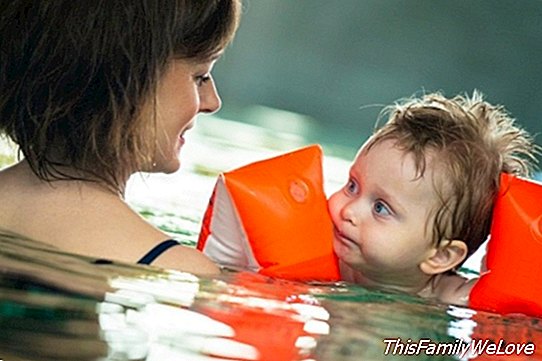Babies in the water: how to learn to walk

Infant stimulation for babies in the water is a technique used to work the child's psychomotor apparatus. Your child makes contact with the aquatic environment, loses the fear of water but with respect and interacts with other children and their parents. In addition, it is very useful at this time of year because summer is approaching and with it, the pools and the sea, those great strangers for the little ones.
The first dip of the baby in the water
This activity must be carried out with a didactic method based on the "Pedagogy of success" and intends to put babies in contact with the aquatic environment, preparing them, among other things, for the arrival of summer since, thanks to the aquatic stimulation by the permanent contact with the mother, or with the father, the baby gets accustomed to the water, overcome the fears, develop physically and mentally and enjoy a deeper and richer family contact. Thus, dads can face the summer period with the reassurance that pools and waves of the sea are not going to be an inconvenience, nor a fearsome unknown for babies, who also will make their first steps as great swimmers.
Babies in the water: 1-2 years
Between 1 and 2 years, children begin to explore the environment and increase their security and independence. At this age, babies already have an incipient autonomous movement, which is crawling and walking. With these advances on the mainland, it's now about teaching babies to move freely in the water with aquatic stimulation (with churritos and backpacks), in a vertical position, pedaling with the legs as if walking or running, giving them the possibility of further enhancing their little legs and discovering the water in a different way. Although parents continue to accompany and help them, children are no longer so dependent on them, making small trips, turns, splashes, etc. Babies, with water discover a different world, which has its own securities and insecurities, which babies must discover.
In addition, it is a time of separation of the baby from their parents, which must be done little by little and adapted to their psychological needs. Begin to introduce standards and small guidelines so that water is both fun and safe at the same time. The verticality that they acquire gives them new dimensions of things, favors the establishment of oculo-manual coordinates and the development of fine manipulation, facilitates the interactions between the child-adult and the child-child and, finally, favors the reflection of the march in an unconscious principle and subsequently intentional.
Babies in the water: 2-4 years
Between two and four years old children are in a new phase of their evolution, in which we must take into account that they are already perfectly handled in the water and even that some do it without auxiliary flotation means, moving like fish in the water and beginning to synchronize their arms and legs, making large movements. They already have very developed psychomotor skills in water. In addition, among other things, are already able to carry out long and deep dives without any problem, perfectly controlling your breathing and your body. They jump from the curb by themselves, with combined dives and exits to the surface with total naturalness.
From now on, children enjoy the water exaggeratedly, of their environment and of everything they have learned with it and there is no one to stop them: they are authentic mermen and mermaids.
In these moments, it will be when new activities are introduced according to each child, focused on learning to swim, with new concepts such as horizontality and independent buoyancy, which learn quickly and execute with great enthusiasm. They respect the rules and understand the dangers of water, although the latter must always be remembered frequently for their own good.
Babies in the water: 3 years
After three years, they are even more expert, as they fine-tune movements, speed, precision and strength. It's time to perfect your coordination of arms and legs and to improve your balance. All this is done in addition, working in a climate of security and confidence, reinforcing their self-esteem and the relationship with other adults and children.
Monica Campa
Advisor: Laura Cruz. Valley physiotherapist36.




